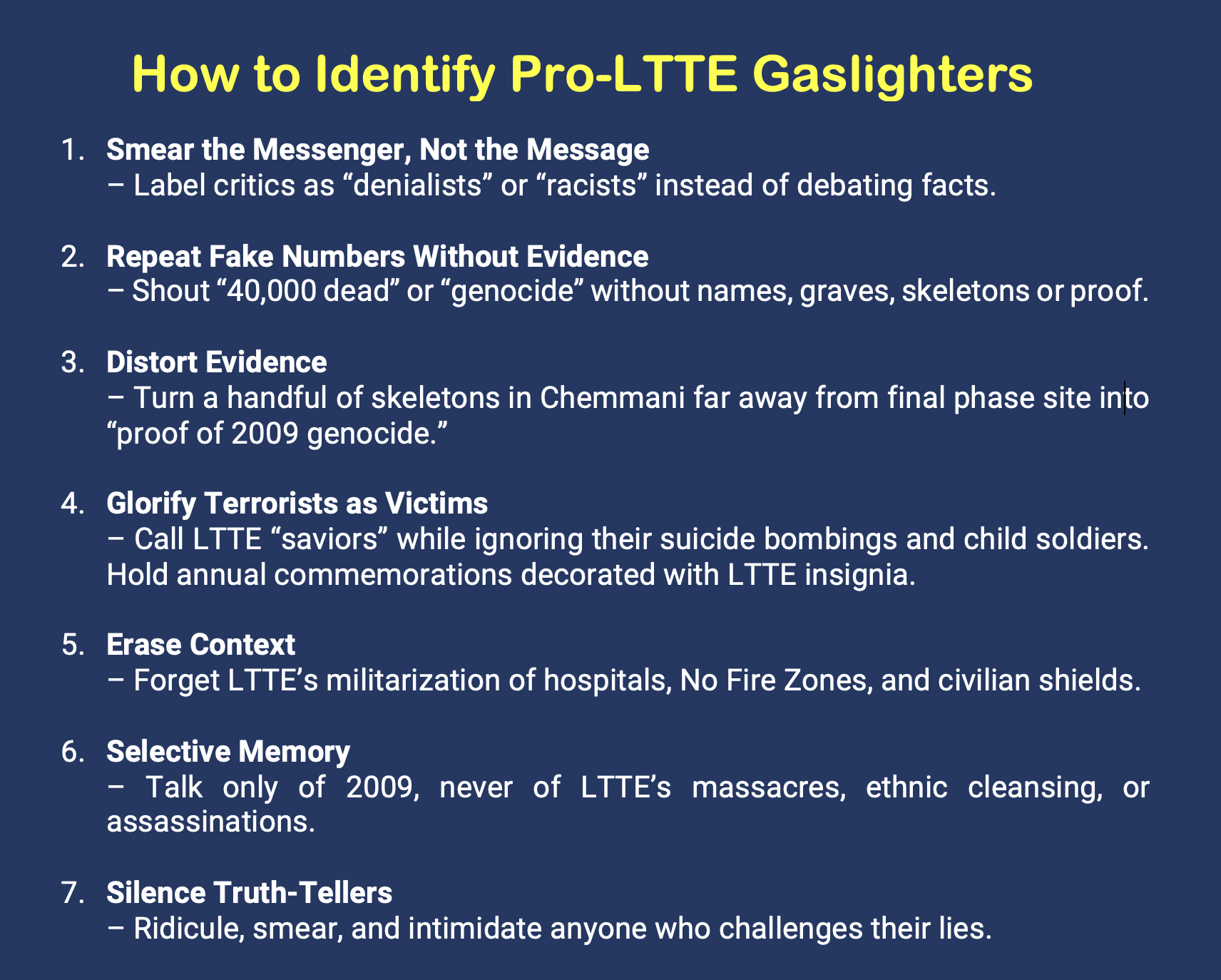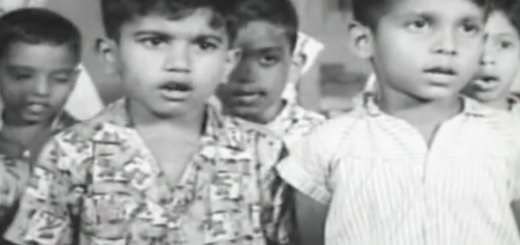Responding to Smear Campaigns: Why Facts still matter in Sri Lanka’s Story

When facts cannot be countered, character assassination begins. When critics cannot counter facts, they turn to insults. Too often, anyone who names inconvenient truths is met not with evidence but with ridicule — a classic playbook of the modern gaslighter. The aim is not to debate but to neutralize truth-tellers: smear the messenger, twist the message, and repeat unverified claims until repetition is mistaken for proof. That is how public debate dies. It is time to call out these smear merchants for what they are — hired political gaslighters. We must defend all who tell the truth and dare to call a spade a spade.
The “Bones” and the Politics of Memory
Much has been made of graves in Mannar, Chemmani, and Mullaitivu.
Their insinuation is simple: every bone equals genocide, every excavation equals 2009.
Yet science and context tell a different story.
Mannar (2018–19):
Excavations uncovered 346 skeletons, but carbon dating placed them in the 15th–18th centuries — long before Sri Lanka’s modern conflict. The attempt to link them to 2009 was demonstrably false.
Chemmani (Jaffna):
Excavations found only a handful of remains, not hundreds, and Chemmani sits over 100 km from Mullivaikkal, where the final battles occurred. Stretching Chemmani into ‘proof’ of 2009 atrocities is not just distortion — it is a calculated lie.
Take a map & see for yourself.
Mullaitivu:
Recent graves are under forensic review. Given that Mullaitivu was under LTTE control for decades, where executions of dissenters, deserters, and civilians were routine, attribution without conclusive evidence is premature. Why do these same gaslighters erase from memory the Thunukkai LTTE torture camp, where over 3,000 Tamils were tortured and killed? Their selective amnesia exposes their agenda.
Even Sri Lanka’s own Office on Missing Persons (OMP) holds some 20,000 complaints spanning multiple eras — from the 1970s JVP insurrection to the Eelam Wars. To compress this complex history into a single narrative of “2009 genocide” is a gross distortion. If the past is to be excavated honestly, it must include the full sweep of history: colonial massacres, foreign invasions, insurgencies, and LTTE crimes. Selective excavation is selective justice — and selective justice is political theatre.
Inflated numbers and the Darusman Report
The oft-cited figure of “40,000 civilian deaths” has been repeated so often it is treated as immutable. Yet its foundation is weak. It traces back to the 2011 Darusman Panel — a report that explicitly stated it was not a fact-finding mission and relied heavily on anonymous and unverified testimony. Moreover, the then UNSG flew over the conflict site 3 days after it ended. Surely his helicopter and the foreign delegations aboard would have noticed mass graves if they existed. None were reported. Has anyone ever wondered how 40,000 could be fit into graves and the area need for such a mass burial? Please visualize before believing lies. Surely people have been given brains to analyze and filter fact from fiction.
By contrast, contemporaneous records and even pro-LTTE sources reported far lower tallies:
- UN Country Team in Colombo:~7,000 civilian deaths recorded up to April 2009.
- TamilNet (official LTTE website):Daily reports during the final phase cited roughly 7,398 civilian deaths by May 2009.
- Gordon Weiss (UN spokesman, 2009):initially referenced 7,000–10,000 deaths before larger unsubstantiated figures circulated.
- Sri Lanka Census (2012):found discrepancies in the Northern Province on the order of ~8,000 — many identified as LTTE cadres.
All the figures hover around 7000-8000 figure.
It is only 3rd party / 4th party unknown entities quoting 40,000 – some even 200,000.
Numbers acquire credibility only when backed by names, forensic evidence, or transparent methodology — not by repetition.
For over a decade, the promoters of the larger figure have failed to provide verifiable lists, identities, or mass graves linked to 2009. That absence of evidence deserves to be treated as what it is: a profound weakness in a politically useful narrative.
Bizarre as it is are we to imagine the Sri Lankan Army “killed 40,000” in May 2009 and took just 240 dead bodies 100km from Mullaivaikkal to Chemmani & buried them!
Hospitals, Human Shields, and International Law
Critics cite the shelling of hospitals and so-called “No Fire Zones.” They repeatedly omit a crucial fact: the LTTE embedded artillery and fighters inside civilian structures, turning hospitals, schools, and evacuation zones into combat space. For civilians forced to remain under duress, fleeing meant risking execution; remaining meant being used as human shields.
International humanitarian law protects medical facilities — but when those facilities are militarized by a party to the conflict, their protected status is compromised. Eyewitness testimony, UN cables, and accounts from Tamil civilians consistently point to LTTE tactics that endangered the very people they claimed to protect. Selective accusation that ignores this context is intellectual dishonesty, not moral clarity.
The Missing: Diaspora Truth vs. Ground Reality
How can all missing persons be charged against the State?
The facts are more complex:
- Office on Missing Persons (OMP):received roughly 20,000 complaints, spanning decades. Approximately 5,000 of these are missing soldiers, recorded with names, regiments, and service details.
- ICRC records:confirm many were last seen in LTTE custody.
- Post-2009 diaspora migration:thousands of LTTE cadres left the country and later surfaced abroad as asylum seekers in Canada, the UK, France, and elsewhere — many of whom were once counted among the “missing.” Remember the story of Kathiravel Thayaparaja – he was accused to have been tortured & killed by the Sri Lankan Army on 13th September 2009. The University Teachers for Human Rights – Jaffna claimed he was arrested & tortured at a security camp in Avissawellla & shot on 13th Sept 2009. The Australian Govt Refugee Review Tribunal in Feb 2010 too claimed he was tortured & killed so did War without Witnesses report, the European Centre for Constitutional & Human Rights report as well as UNHRC reports carried this incident.
Then the “dead” Thayaparaja was arrested by the Dhanushkodi Police on 5 May 2014. (declared dead in 2009 & found alive in 2014)
None of the NGOs, reports, or UN bodies that falsely accused the Armed Forces retracted their claims or apologized. That silence proves the impunity with which propaganda operates.
This incident illustrates the kind of fabricated narratives Sri Lanka continues to battle.
This is not to diminish the profound grief of families who lost loved ones.
But grief must not be weaponized into blanket accusations.
Two distinctions must be insisted upon:
(1) civilian vs. combatant — LTTE personnel engaged in hostilities cannot legitimately be reclassified as civilians; LTTE had a civilian trained armed force. None of these dead are classified as civilians.
(2) victim vs. perpetrator — sympathy rightly belongs first to innocent civilians. Not all the missing are dead; not all the dead are civilians.
Denying these distinctions is the real distortion.
Channel 4 and the Propaganda Cycle
Channel 4 documentaries are repeatedly presented as definitive evidence. But their timing — frequently premiering before UNHRC sessions — and their production model (advocacy-driven, funded projects) raise legitimate questions about intent and methodology.
Moreover, the same bandwagon of pro-LTTE activists are found promoting it worldwide.
Forensic experts have raised concerns about editing, splicing, and unverifiable sourcing. In a courtroom, such material would face admissibility challenges.
War crimes prosecutions require verifiable, court-tested evidence, not emotive television specials scripted to influence diplomatic outcomes. Media can illuminate, but it cannot replace evidence or due process. Justice cannot be scripted for television or social media.
Sanctions Are Political, Not Judicial
Sanctions are tools of foreign policy, not verdicts handed down by impartial courts. Countries — for geopolitical reasons — choose whom to sanction and when. If sanctions are presented as equivalent to judicial findings, the conversation becomes dishonest. The global record shows selective application of punitive measures; the same scrutiny is seldom applied uniformly across conflicts and actors.
Development as Healing, Not Erasure
Dismissing reconstruction — roads, schools, hospitals, the return of elections — as mere “asphalting over bloodstains” misunderstands both healing and resilience. These are not cosmetic fixes. They are the infrastructure of normal life and the tangible proof that communities chose pens, classrooms, and livelihoods over guns and recruitment.
Anyone who has seen the North before 2009 and returns today will witness profound change: generations once vulnerable to forced conscription now hold pens, not guns. That generational shift matters. Reconciliation requires acknowledging harm to all communities — Sinhala, Tamil, and Muslim — and refusing to let wounds be perpetually exploited for separatist agendas. Terrorism extended beyond Sri Lankan borders; victims include foreigners as well. Honouring all victims, not weaponizing their memory, is the path to durable peace.
The Real Denial
The true denial is not the defence of verified facts; it is the refusal to recognize the LTTE’s crimes:
- Ethnic cleansingof Muslims and Sinhalese from the North in the 1990s.
- Systematic recruitment of child soldiers.
- Suicide bombingsin buses, temples, and public spaces.
- Turning civilians into human shields.
Yet those who raise these points are attacked as “denialists.”
At Geneva 2025 some marchers openly glorified the LTTE and demanded retention of arms — placards that read, in effect, “do not demand they lay down their weapons.” Others make sweeping claims of “genocide” without providing names, numbers, or verifiable evidence. By glorifying the LTTE and demanding its weapons be preserved, these activists show where they stand — with the terrorists, not the victims.
They have proved by their own actions in Geneva 2025.
Moreover, the irony that the Commander of the Armed Forces is not included into the calls for “war crimes” while select field officers are, and the same Commander contesting Presidential Elections the year after the defeat of the LTTE got all Tamil votes & had even the TNA campaign for him tells much of the hypocrisies that prevail.
Facts will outlast Smears
If exposing facts is labeled denial, then truth itself is under siege. Character assassination cannot erase evidence; rhetoric cannot substitute for forensic proof.
Bring on counter arguments not meek smear campaigns.
Sri Lanka fought a war against terrorism; its peace is imperfect but real. The bones we must honour are those of all victims — Tamil, Sinhala, Muslim — not props in a political theatre.
The gaslighters seek to neutralize truth by destroying credibility through smear. We must refuse to let them succeed. The past must be excavated honestly, remembered fully, and taught fairly. That is the only road to genuine reconciliation. We don’t need to reconcile with terrorists. The armed forces fought against terrorists not Tamils. It’s a pity that terrorist promoters who display LTTE flags, emblems and insignia are the ones continuing to keep alive the flame of terror towards separatism though holding foreign passports, living in foreign climes, educating their children overseas but wanting their own people back home to return to the jungles and destroy another generation of Tamil children as child soldiers. Tamils in Sri Lanka should not fall for these tricks any longer.
The world too must learn to separate facts from lies, for only then can justice be genuine and peace be lasting.
Shenali D Waduge
On behalf of all those who have the right to speak and write the truth







